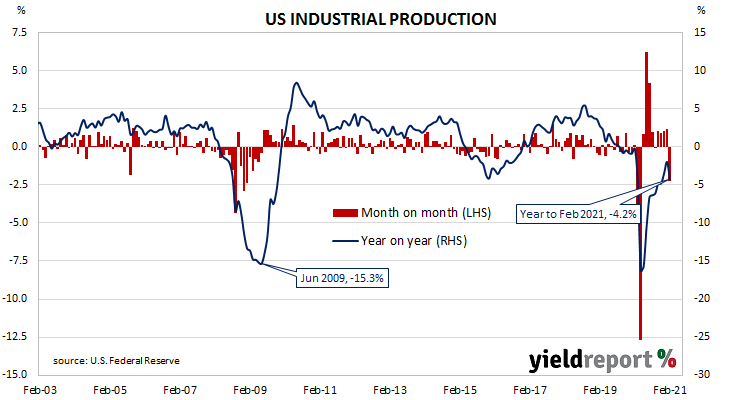Summary: US output contracts in February; fall in contrast to expected figure; cold weather, supply chain issues blamed; capacity utilisation rate drops back to November level.
The Federal Reserve’s industrial production (IP) index measures real output from manufacturing, mining, electricity and gas company facilities located in the United States. These sectors are thought to be sensitive to consumer demand and so some leading indicators of GDP use industrial production figures as a component.
Production began recovering in May 2020 and subsequent months after collapsing in the previous two months.
US industrial production contracted by 2.2% on a seasonally adjusted basis in February, the first negative result since September. The result was in contrast to the 0.6% increase which had been generally expected and January’s 1.1% rise after it was revised up from 0.9%. On an annual basis, the contraction rate increased from January’s revised figure of -2.0% to -4.2%
NAB senior economist David de Garis pointed to the Fed’s statement that “‘severe winter weather in the south central region of the country in mid-February accounted for the bulk of the declines in output for the month.”. Westpac economist Lochlan Halloway noted there also were “some supply chain issues.”

The report was released on the same day as February’s retail sales numbers and, despite the soft figures, longer-term US Treasury bond yields moved a little higher. By the end of the day, the 10-year Treasury yield had inched up 1bps to 1.62% and the 30-year yield had added 2bps to 2.38%. The 2-year yield remained unchanged at 0.15%.
The same report includes US capacity utilisation figures which are generally accepted as an indicator of future investment expenditure and/or inflationary pressures. Capacity usage had hit a high for the last business cycle in early 2019 before it began a downtrend which ended with April 2020’s multi-decade low of 64.2%. February’s reading fell from January’s revised figure of 75.5% from 73.8%, a similar level to that of November.

